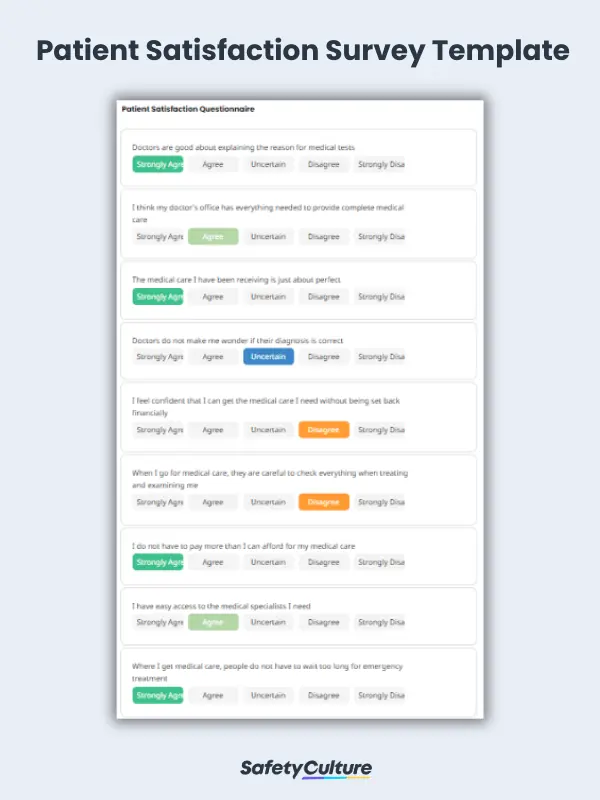What is a Patient Satisfaction Survey?
A patient satisfaction survey is a tool used to gather patient feedback regarding the quality of service and medical treatment provided by hospitals and medical practices. Patient satisfaction is equally important as customer satisfaction. With greater scrutiny on patient experience driven by online review sites and government star rating systems (HCAHPS), patient surveys can help practices identify, measure, and address performance gaps.
Which Patient Satisfaction Survey Standard Should I Use?
According to an article in the Oman Medical Journal, there are three patient satisfaction survey standards in use today: PSQ-18; HCAHPS; and PEQ-15. The major difference between them is the number of questions they ask. PSQ-18 has 18 questions, HCAHPS has 29 questions, and PEQ-15 has 15 questions. The three patient satisfaction survey standards also measure different aspects of patient experience as can be seen in the table below.
| Patient Satisfaction Survey Standards | ||
| PSQ-18 | HCAHPS | PEQ-15 |
| Discharge information | Information and education | |
| Communication | Communication with nurses and doctors | Coordination of care |
| Technical quality | Cleanliness and quietness of the hospital environment | Physical comfort |
| Time spent with a doctor | Emotional support | |
| Accessibility of care | Responsiveness of hospital staff | Respect for patient preferences |
| Interpersonal manner | Whether or not they would recommend the hospital | Involvement of family and friends |
| Financial aspects of care | Communication about medicines | Continuity and transition |
| Overall rating of hospital | Overall impression | |
How do I Write a Patient Satisfaction Survey?
After choosing a standard to use as the basis for your patient satisfaction surveys, it’s time to start thinking of the questions you’ll ask. While writing a patient satisfaction survey can be a daunting task, it is ultimately a necessary part of running a practice, clinic, or hospital. Your patients are the most important part of your business, and these surveys can help you deliver a better experience so they’ll keep coming back. Ensure that patients get the care and attention they need with these three easy tips:
Tip #1 Create simple questions that are easy to answer
Know what needs to be measured so that you can create relevant questions that are also easy for patients to answer. The goal of a patient satisfaction survey is to better understand the patient experience. The following are some of the common questions asked in a patient satisfaction survey questions:
- Is my doctor able to explain the reason for medical tests well?
- Does my doctor have all the necessary equipment and tools to provide complete medical care?
- Did I have to wait too long to get medical treatment?
- Do doctors and medical staff treat me in a courteous and friendly manner?
- Am I satisfied with the medical care I receive?
Here is an example patient satisfaction survey questionnaire with 18 standard questions you can download and customize for your practice.
Tip #2 Plan on how the patient survey will be conducted
The patient’s welfare should always be given the utmost consideration. Conduct the patient survey at the patient’s earliest convenient time. You can do the patient survey while they are in the waiting room before a doctor’s appointment or before checking out post-admission. You can also conduct surveys through a phone call; however, delays should be avoided in conducting the patient survey because this can have a negative impact on overall patient satisfaction.
Tip #3 Take advantage of available technology
Technology has made conducting surveys more convenient and streamlined. Unlike paper-based patient questionnaires, digital patient satisfaction surveys allow the collection of data via mobile devices at the patient’s convenience. Patient surveys conducted through strategically placed kiosks have better chances of being completed while the patient experience is still fresh.
FAQs About Patient Satisfaction Survey
Patient Satisfaction Surveys document relevant data and information that healthcare providers can use to identify areas for improvement, enhance the quality of their services, establish effective communication, and create better relationships with their patients.
According to a study published in ResearchGate, the most important factors affecting a patient’s satisfaction are the quality of healthcare, ease of access, care, communication, and other tangibles. Other dimensions mentioned were costs, physician role and behavior, and healthcare processes.
Now that you’ve made patient satisfaction surveys easy for your patients, it’s time to make them easy for your staff, too. Another benefit of using technology for your patient satisfaction surveys is that it’s now possible for your doctors and nurses to access survey results on any mobile device. With the information they need to improve right in their hands, your staff will be empowered to do their best everyday and in any situation.


